Cybercrime: Analysis of Investment Frauds, Prevention & Responses
VerifiedAdded on 2022/10/06
|15
|3455
|17
Report
AI Summary
This report provides an in-depth analysis of investment frauds within the realm of cybercrime, highlighting the increasing prevalence and sophistication of these crimes due to technological advancements. It identifies the report's target audience as internet users, IT security practitioners, and law enforcement officers, aiming to serve as an educational resource for developing vigilant response mechanisms and promoting secure online behavior. The report defines investment fraud, examines its prevalence using statistical data, and explores elements of the crime, including the context, methods employed by offenders (such as source credibility, social consensus, and reciprocity), and the patterns of victimization. Furthermore, it investigates responses to the crime problem, detailing crime prevention strategies and legal enforcement efforts. The report concludes by emphasizing the need for continuous adaptation in security measures to combat evolving cyber threats. Desklib offers more resources for students.

Running head: Investment Frauds 1
Understanding and Preventing Cyber Fraud
Name of the Student
Name of the Institution
Understanding and Preventing Cyber Fraud
Name of the Student
Name of the Institution
Paraphrase This Document
Need a fresh take? Get an instant paraphrase of this document with our AI Paraphraser
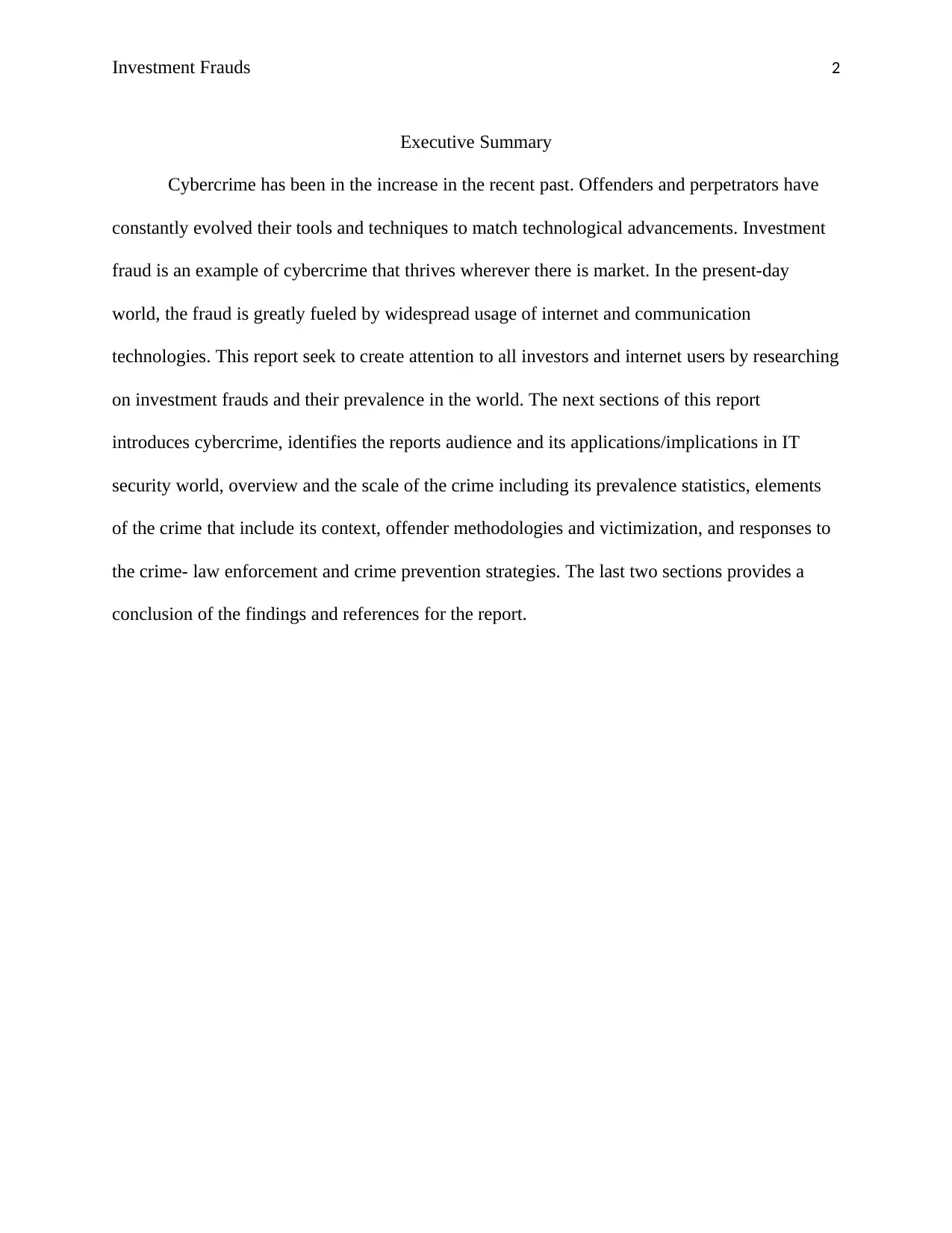
Investment Frauds 2
Executive Summary
Cybercrime has been in the increase in the recent past. Offenders and perpetrators have
constantly evolved their tools and techniques to match technological advancements. Investment
fraud is an example of cybercrime that thrives wherever there is market. In the present-day
world, the fraud is greatly fueled by widespread usage of internet and communication
technologies. This report seek to create attention to all investors and internet users by researching
on investment frauds and their prevalence in the world. The next sections of this report
introduces cybercrime, identifies the reports audience and its applications/implications in IT
security world, overview and the scale of the crime including its prevalence statistics, elements
of the crime that include its context, offender methodologies and victimization, and responses to
the crime- law enforcement and crime prevention strategies. The last two sections provides a
conclusion of the findings and references for the report.
Executive Summary
Cybercrime has been in the increase in the recent past. Offenders and perpetrators have
constantly evolved their tools and techniques to match technological advancements. Investment
fraud is an example of cybercrime that thrives wherever there is market. In the present-day
world, the fraud is greatly fueled by widespread usage of internet and communication
technologies. This report seek to create attention to all investors and internet users by researching
on investment frauds and their prevalence in the world. The next sections of this report
introduces cybercrime, identifies the reports audience and its applications/implications in IT
security world, overview and the scale of the crime including its prevalence statistics, elements
of the crime that include its context, offender methodologies and victimization, and responses to
the crime- law enforcement and crime prevention strategies. The last two sections provides a
conclusion of the findings and references for the report.

Investment Frauds 3
Contents
Executive Summary.........................................................................................................................2
Understanding and Preventing Cyber Fraud....................................................................................3
Introduction......................................................................................................................................3
Aims and Objectives of the Report..............................................................................................4
Target Audience...........................................................................................................................4
Report Application and Implications...........................................................................................5
Overview of Investment Fraud........................................................................................................5
Definition of Investment Fraud....................................................................................................5
Prevalence Statistics.....................................................................................................................5
Elements of Investment Fraud Crime..............................................................................................6
Context of Investment Fraud........................................................................................................6
Victimization................................................................................................................................7
Offender Methodologies..............................................................................................................7
Responses to Crime Problem.........................................................................................................10
Crime Prevention.......................................................................................................................10
Legal Enforcement.....................................................................................................................10
Conclusions....................................................................................................................................12
References......................................................................................................................................14
Contents
Executive Summary.........................................................................................................................2
Understanding and Preventing Cyber Fraud....................................................................................3
Introduction......................................................................................................................................3
Aims and Objectives of the Report..............................................................................................4
Target Audience...........................................................................................................................4
Report Application and Implications...........................................................................................5
Overview of Investment Fraud........................................................................................................5
Definition of Investment Fraud....................................................................................................5
Prevalence Statistics.....................................................................................................................5
Elements of Investment Fraud Crime..............................................................................................6
Context of Investment Fraud........................................................................................................6
Victimization................................................................................................................................7
Offender Methodologies..............................................................................................................7
Responses to Crime Problem.........................................................................................................10
Crime Prevention.......................................................................................................................10
Legal Enforcement.....................................................................................................................10
Conclusions....................................................................................................................................12
References......................................................................................................................................14
⊘ This is a preview!⊘
Do you want full access?
Subscribe today to unlock all pages.

Trusted by 1+ million students worldwide

Investment Frauds 4
Understanding and Preventing Cyber Fraud
Introduction
With the widespread development and usage of information and communications
technologies in all aspects of modern-man’s life, so many opportunities have emerged.
Information access and flow is out of state and governmental control, a fact that has enhanced
democracy and improved standards of living for many people due to ease of information access
(ITU, 2012). Most unfortunately, these developments have are coupled with new and serious
security threats. Amazingly, techniques and tools used to attacks information systems advance
and become more sophisticated along with technological developments. While essential services
such as electricity, water, traffic control, air conditioning and communication systems depend on
smooth functioning of information, and communications technologies, attacks against these
infrastructures pose graet danger to the present day tech-defined society.
Important to note is the growth of internet which sits at the core of virtually all
technological developments. While internet has aided communications and information sharing
in a great way, it has been used by malicious intended persons to cause harm on other.
Cybercrimes and cyber frauds perpetrated through the internet and computer systems are in the
increase- in both number and magnitude.
Financial damages caused out of cybercrimes and are reportedly enormous. The figures
were reported to be around USD 17 billion in 2003 and more than USD 100 billion in 2007 (IBM ,
2006). Many organizations today believe that cybercrime is more expensive and hard to deal
with than physical crime. This drives the ICT world into a new era and domain: the
understanding of cybercrime and cyber fraud and the importance of protecting ICT
Understanding and Preventing Cyber Fraud
Introduction
With the widespread development and usage of information and communications
technologies in all aspects of modern-man’s life, so many opportunities have emerged.
Information access and flow is out of state and governmental control, a fact that has enhanced
democracy and improved standards of living for many people due to ease of information access
(ITU, 2012). Most unfortunately, these developments have are coupled with new and serious
security threats. Amazingly, techniques and tools used to attacks information systems advance
and become more sophisticated along with technological developments. While essential services
such as electricity, water, traffic control, air conditioning and communication systems depend on
smooth functioning of information, and communications technologies, attacks against these
infrastructures pose graet danger to the present day tech-defined society.
Important to note is the growth of internet which sits at the core of virtually all
technological developments. While internet has aided communications and information sharing
in a great way, it has been used by malicious intended persons to cause harm on other.
Cybercrimes and cyber frauds perpetrated through the internet and computer systems are in the
increase- in both number and magnitude.
Financial damages caused out of cybercrimes and are reportedly enormous. The figures
were reported to be around USD 17 billion in 2003 and more than USD 100 billion in 2007 (IBM ,
2006). Many organizations today believe that cybercrime is more expensive and hard to deal
with than physical crime. This drives the ICT world into a new era and domain: the
understanding of cybercrime and cyber fraud and the importance of protecting ICT
Paraphrase This Document
Need a fresh take? Get an instant paraphrase of this document with our AI Paraphraser
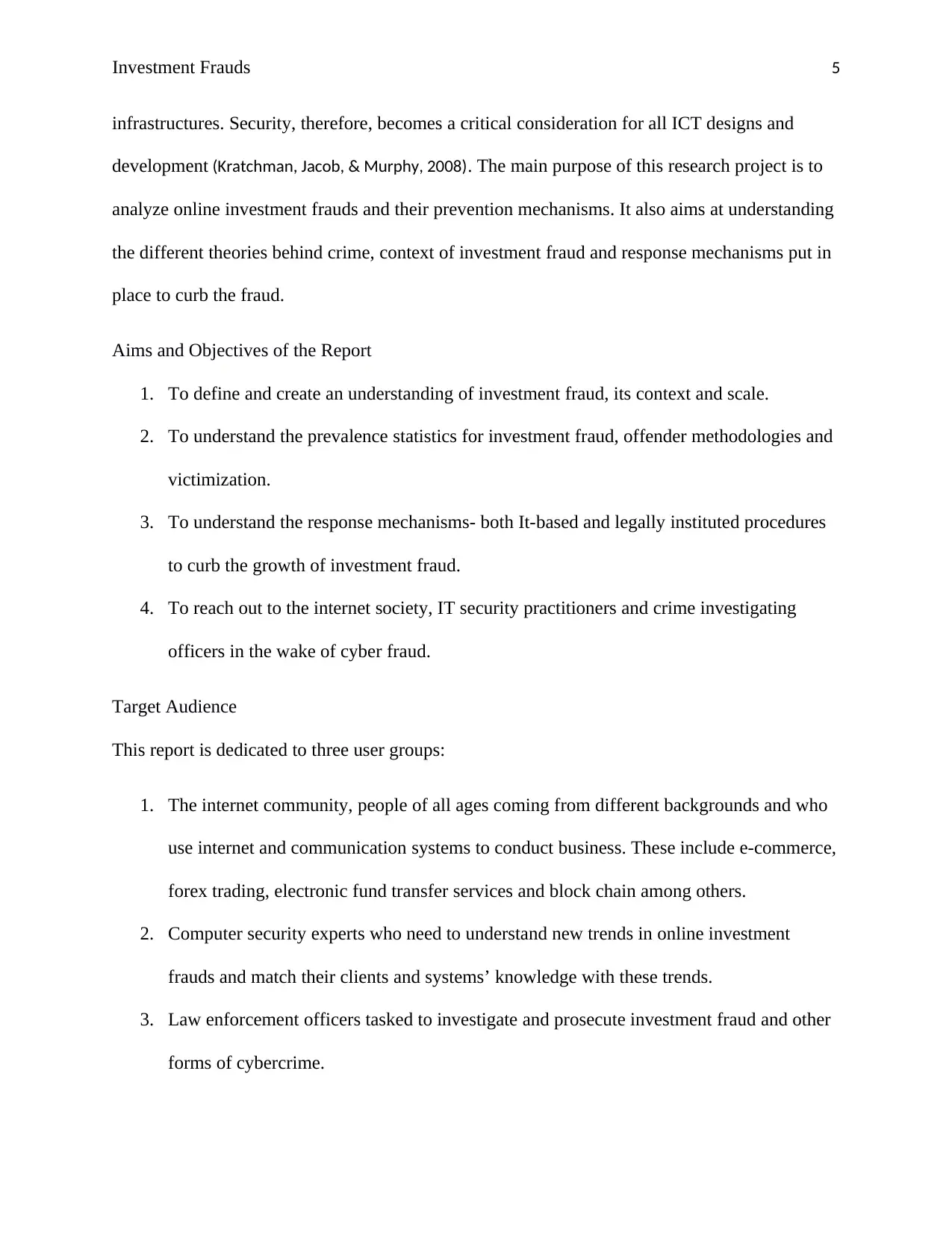
Investment Frauds 5
infrastructures. Security, therefore, becomes a critical consideration for all ICT designs and
development (Kratchman, Jacob, & Murphy, 2008). The main purpose of this research project is to
analyze online investment frauds and their prevention mechanisms. It also aims at understanding
the different theories behind crime, context of investment fraud and response mechanisms put in
place to curb the fraud.
Aims and Objectives of the Report
1. To define and create an understanding of investment fraud, its context and scale.
2. To understand the prevalence statistics for investment fraud, offender methodologies and
victimization.
3. To understand the response mechanisms- both It-based and legally instituted procedures
to curb the growth of investment fraud.
4. To reach out to the internet society, IT security practitioners and crime investigating
officers in the wake of cyber fraud.
Target Audience
This report is dedicated to three user groups:
1. The internet community, people of all ages coming from different backgrounds and who
use internet and communication systems to conduct business. These include e-commerce,
forex trading, electronic fund transfer services and block chain among others.
2. Computer security experts who need to understand new trends in online investment
frauds and match their clients and systems’ knowledge with these trends.
3. Law enforcement officers tasked to investigate and prosecute investment fraud and other
forms of cybercrime.
infrastructures. Security, therefore, becomes a critical consideration for all ICT designs and
development (Kratchman, Jacob, & Murphy, 2008). The main purpose of this research project is to
analyze online investment frauds and their prevention mechanisms. It also aims at understanding
the different theories behind crime, context of investment fraud and response mechanisms put in
place to curb the fraud.
Aims and Objectives of the Report
1. To define and create an understanding of investment fraud, its context and scale.
2. To understand the prevalence statistics for investment fraud, offender methodologies and
victimization.
3. To understand the response mechanisms- both It-based and legally instituted procedures
to curb the growth of investment fraud.
4. To reach out to the internet society, IT security practitioners and crime investigating
officers in the wake of cyber fraud.
Target Audience
This report is dedicated to three user groups:
1. The internet community, people of all ages coming from different backgrounds and who
use internet and communication systems to conduct business. These include e-commerce,
forex trading, electronic fund transfer services and block chain among others.
2. Computer security experts who need to understand new trends in online investment
frauds and match their clients and systems’ knowledge with these trends.
3. Law enforcement officers tasked to investigate and prosecute investment fraud and other
forms of cybercrime.
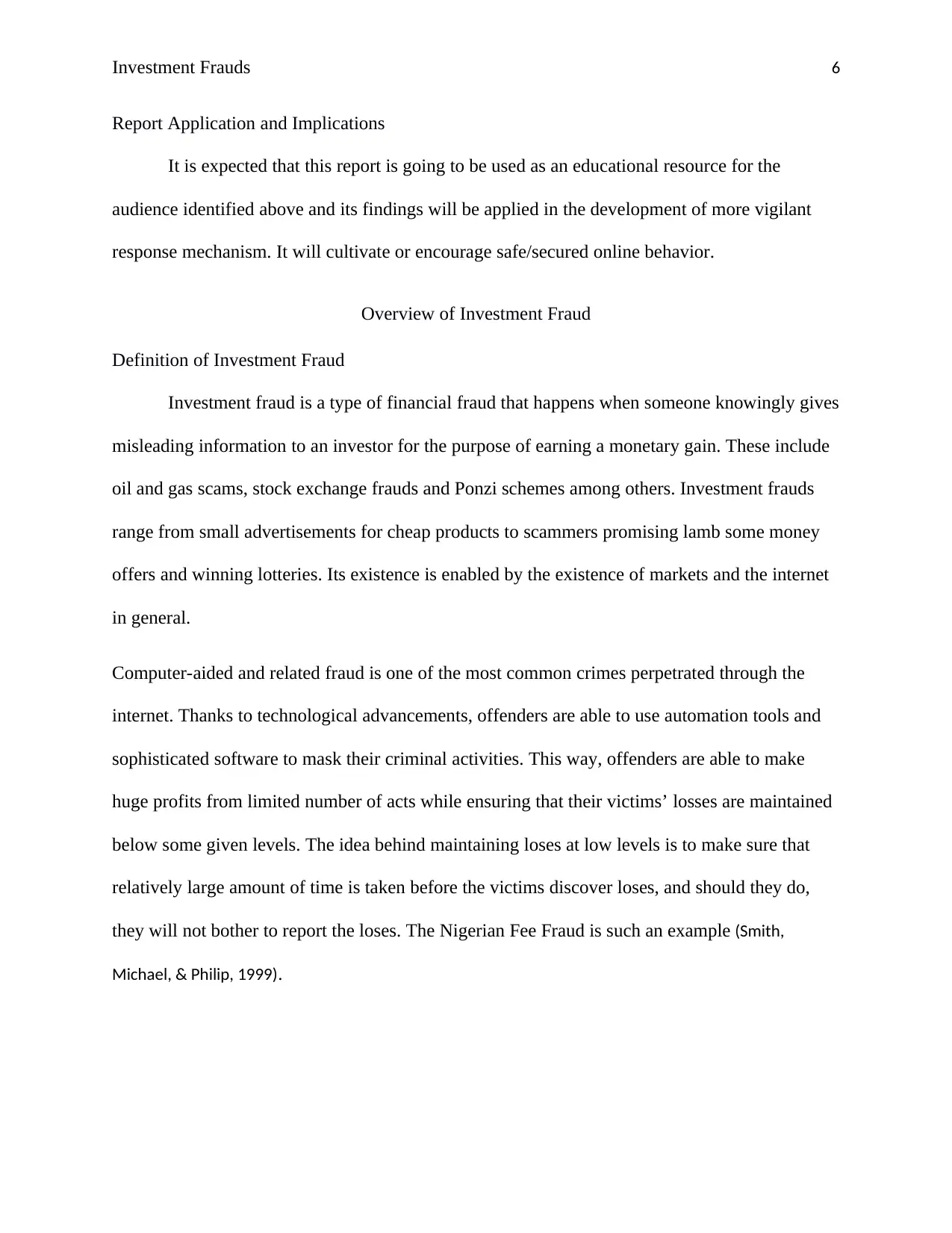
Investment Frauds 6
Report Application and Implications
It is expected that this report is going to be used as an educational resource for the
audience identified above and its findings will be applied in the development of more vigilant
response mechanism. It will cultivate or encourage safe/secured online behavior.
Overview of Investment Fraud
Definition of Investment Fraud
Investment fraud is a type of financial fraud that happens when someone knowingly gives
misleading information to an investor for the purpose of earning a monetary gain. These include
oil and gas scams, stock exchange frauds and Ponzi schemes among others. Investment frauds
range from small advertisements for cheap products to scammers promising lamb some money
offers and winning lotteries. Its existence is enabled by the existence of markets and the internet
in general.
Computer-aided and related fraud is one of the most common crimes perpetrated through the
internet. Thanks to technological advancements, offenders are able to use automation tools and
sophisticated software to mask their criminal activities. This way, offenders are able to make
huge profits from limited number of acts while ensuring that their victims’ losses are maintained
below some given levels. The idea behind maintaining loses at low levels is to make sure that
relatively large amount of time is taken before the victims discover loses, and should they do,
they will not bother to report the loses. The Nigerian Fee Fraud is such an example (Smith,
Michael, & Philip, 1999).
Report Application and Implications
It is expected that this report is going to be used as an educational resource for the
audience identified above and its findings will be applied in the development of more vigilant
response mechanism. It will cultivate or encourage safe/secured online behavior.
Overview of Investment Fraud
Definition of Investment Fraud
Investment fraud is a type of financial fraud that happens when someone knowingly gives
misleading information to an investor for the purpose of earning a monetary gain. These include
oil and gas scams, stock exchange frauds and Ponzi schemes among others. Investment frauds
range from small advertisements for cheap products to scammers promising lamb some money
offers and winning lotteries. Its existence is enabled by the existence of markets and the internet
in general.
Computer-aided and related fraud is one of the most common crimes perpetrated through the
internet. Thanks to technological advancements, offenders are able to use automation tools and
sophisticated software to mask their criminal activities. This way, offenders are able to make
huge profits from limited number of acts while ensuring that their victims’ losses are maintained
below some given levels. The idea behind maintaining loses at low levels is to make sure that
relatively large amount of time is taken before the victims discover loses, and should they do,
they will not bother to report the loses. The Nigerian Fee Fraud is such an example (Smith,
Michael, & Philip, 1999).
⊘ This is a preview!⊘
Do you want full access?
Subscribe today to unlock all pages.

Trusted by 1+ million students worldwide
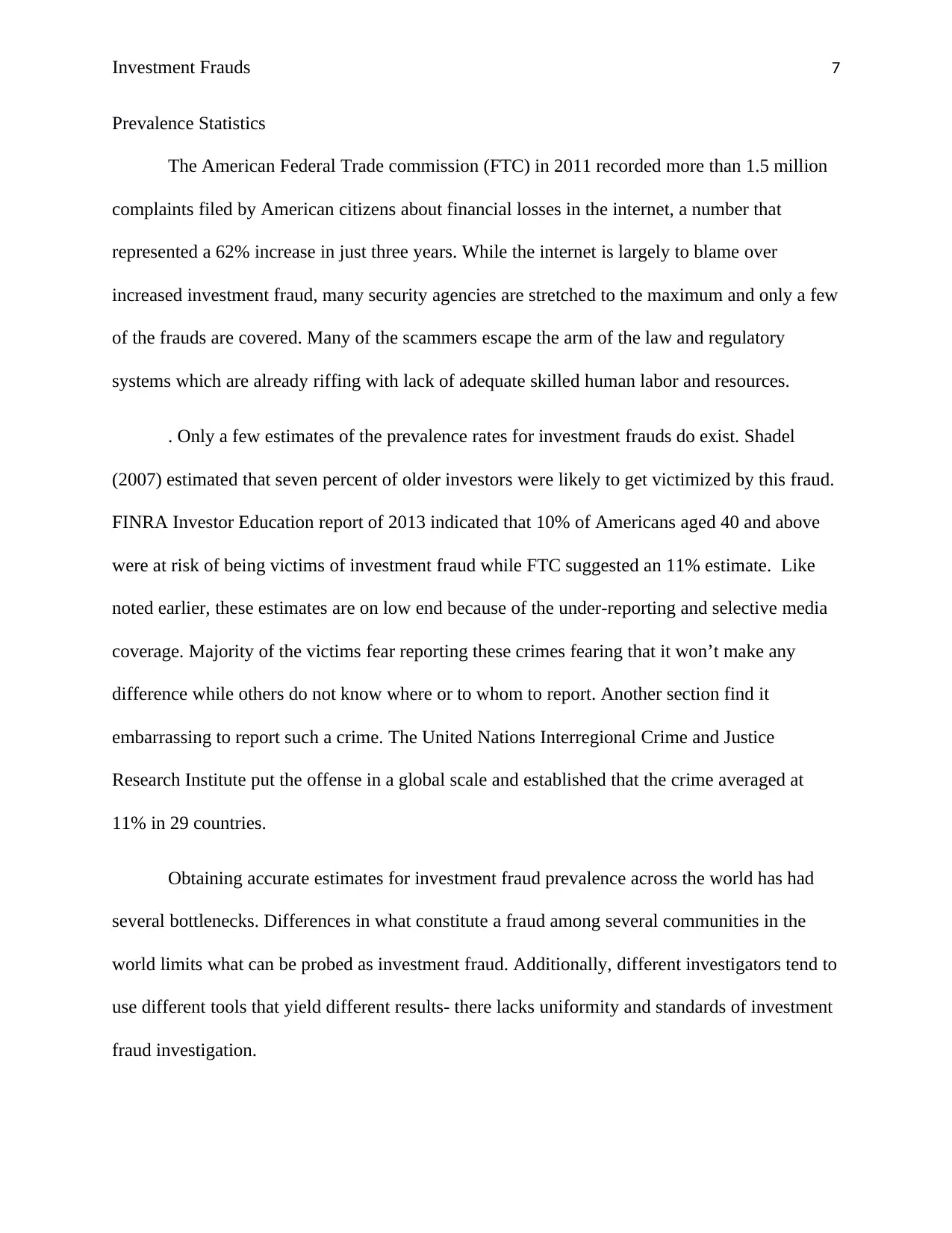
Investment Frauds 7
Prevalence Statistics
The American Federal Trade commission (FTC) in 2011 recorded more than 1.5 million
complaints filed by American citizens about financial losses in the internet, a number that
represented a 62% increase in just three years. While the internet is largely to blame over
increased investment fraud, many security agencies are stretched to the maximum and only a few
of the frauds are covered. Many of the scammers escape the arm of the law and regulatory
systems which are already riffing with lack of adequate skilled human labor and resources.
. Only a few estimates of the prevalence rates for investment frauds do exist. Shadel
(2007) estimated that seven percent of older investors were likely to get victimized by this fraud.
FINRA Investor Education report of 2013 indicated that 10% of Americans aged 40 and above
were at risk of being victims of investment fraud while FTC suggested an 11% estimate. Like
noted earlier, these estimates are on low end because of the under-reporting and selective media
coverage. Majority of the victims fear reporting these crimes fearing that it won’t make any
difference while others do not know where or to whom to report. Another section find it
embarrassing to report such a crime. The United Nations Interregional Crime and Justice
Research Institute put the offense in a global scale and established that the crime averaged at
11% in 29 countries.
Obtaining accurate estimates for investment fraud prevalence across the world has had
several bottlenecks. Differences in what constitute a fraud among several communities in the
world limits what can be probed as investment fraud. Additionally, different investigators tend to
use different tools that yield different results- there lacks uniformity and standards of investment
fraud investigation.
Prevalence Statistics
The American Federal Trade commission (FTC) in 2011 recorded more than 1.5 million
complaints filed by American citizens about financial losses in the internet, a number that
represented a 62% increase in just three years. While the internet is largely to blame over
increased investment fraud, many security agencies are stretched to the maximum and only a few
of the frauds are covered. Many of the scammers escape the arm of the law and regulatory
systems which are already riffing with lack of adequate skilled human labor and resources.
. Only a few estimates of the prevalence rates for investment frauds do exist. Shadel
(2007) estimated that seven percent of older investors were likely to get victimized by this fraud.
FINRA Investor Education report of 2013 indicated that 10% of Americans aged 40 and above
were at risk of being victims of investment fraud while FTC suggested an 11% estimate. Like
noted earlier, these estimates are on low end because of the under-reporting and selective media
coverage. Majority of the victims fear reporting these crimes fearing that it won’t make any
difference while others do not know where or to whom to report. Another section find it
embarrassing to report such a crime. The United Nations Interregional Crime and Justice
Research Institute put the offense in a global scale and established that the crime averaged at
11% in 29 countries.
Obtaining accurate estimates for investment fraud prevalence across the world has had
several bottlenecks. Differences in what constitute a fraud among several communities in the
world limits what can be probed as investment fraud. Additionally, different investigators tend to
use different tools that yield different results- there lacks uniformity and standards of investment
fraud investigation.
Paraphrase This Document
Need a fresh take? Get an instant paraphrase of this document with our AI Paraphraser
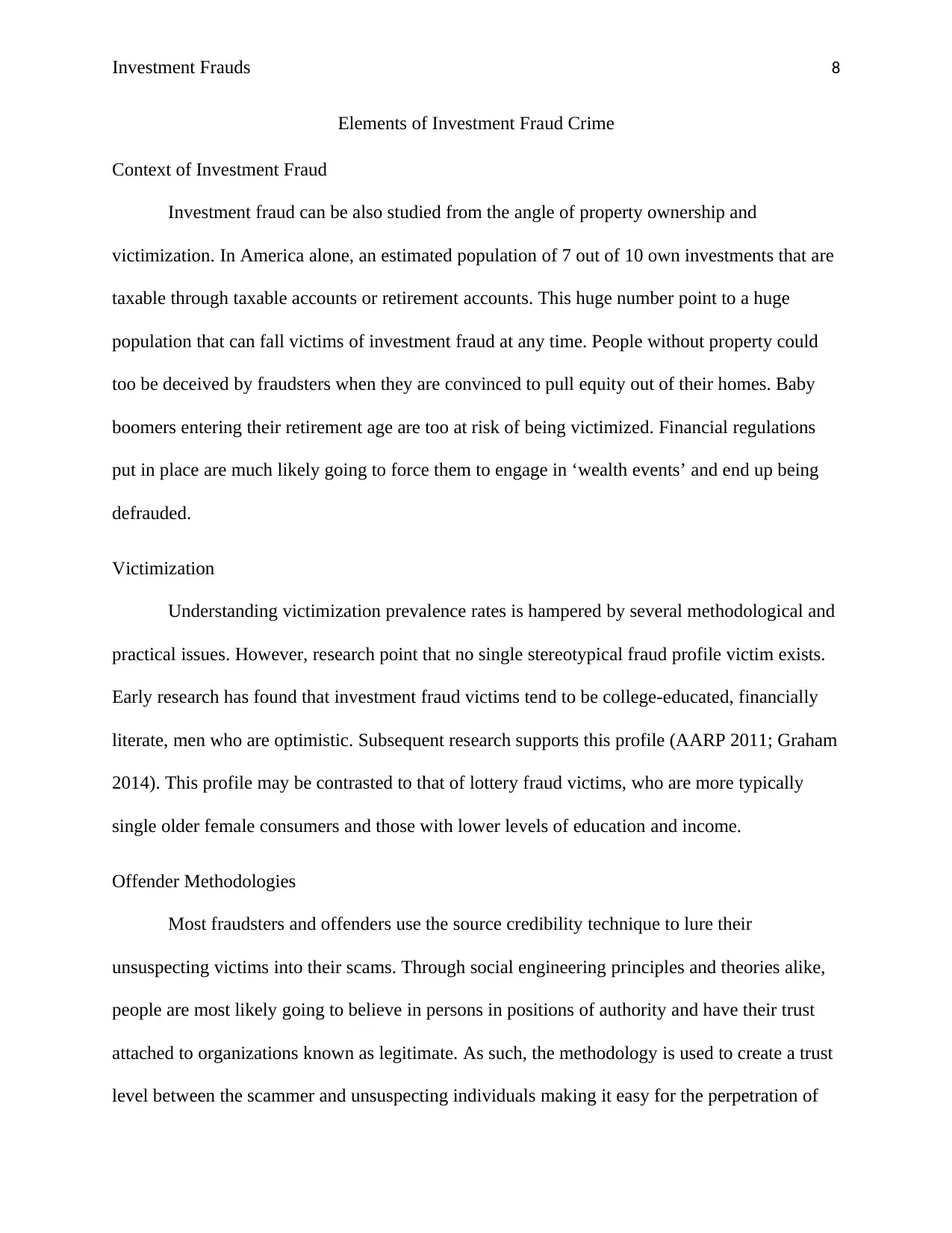
Investment Frauds 8
Elements of Investment Fraud Crime
Context of Investment Fraud
Investment fraud can be also studied from the angle of property ownership and
victimization. In America alone, an estimated population of 7 out of 10 own investments that are
taxable through taxable accounts or retirement accounts. This huge number point to a huge
population that can fall victims of investment fraud at any time. People without property could
too be deceived by fraudsters when they are convinced to pull equity out of their homes. Baby
boomers entering their retirement age are too at risk of being victimized. Financial regulations
put in place are much likely going to force them to engage in ‘wealth events’ and end up being
defrauded.
Victimization
Understanding victimization prevalence rates is hampered by several methodological and
practical issues. However, research point that no single stereotypical fraud profile victim exists.
Early research has found that investment fraud victims tend to be college-educated, financially
literate, men who are optimistic. Subsequent research supports this profile (AARP 2011; Graham
2014). This profile may be contrasted to that of lottery fraud victims, who are more typically
single older female consumers and those with lower levels of education and income.
Offender Methodologies
Most fraudsters and offenders use the source credibility technique to lure their
unsuspecting victims into their scams. Through social engineering principles and theories alike,
people are most likely going to believe in persons in positions of authority and have their trust
attached to organizations known as legitimate. As such, the methodology is used to create a trust
level between the scammer and unsuspecting individuals making it easy for the perpetration of
Elements of Investment Fraud Crime
Context of Investment Fraud
Investment fraud can be also studied from the angle of property ownership and
victimization. In America alone, an estimated population of 7 out of 10 own investments that are
taxable through taxable accounts or retirement accounts. This huge number point to a huge
population that can fall victims of investment fraud at any time. People without property could
too be deceived by fraudsters when they are convinced to pull equity out of their homes. Baby
boomers entering their retirement age are too at risk of being victimized. Financial regulations
put in place are much likely going to force them to engage in ‘wealth events’ and end up being
defrauded.
Victimization
Understanding victimization prevalence rates is hampered by several methodological and
practical issues. However, research point that no single stereotypical fraud profile victim exists.
Early research has found that investment fraud victims tend to be college-educated, financially
literate, men who are optimistic. Subsequent research supports this profile (AARP 2011; Graham
2014). This profile may be contrasted to that of lottery fraud victims, who are more typically
single older female consumers and those with lower levels of education and income.
Offender Methodologies
Most fraudsters and offenders use the source credibility technique to lure their
unsuspecting victims into their scams. Through social engineering principles and theories alike,
people are most likely going to believe in persons in positions of authority and have their trust
attached to organizations known as legitimate. As such, the methodology is used to create a trust
level between the scammer and unsuspecting individuals making it easy for the perpetration of

Investment Frauds 9
crime. Appealing statements are used to win potential victims’ hearts. The FINRA Investor
Education Foundation for example in 2013 tested the statement “We are a highly regarded and
profitable investment management company specializing in the foreign exchange markets,
futures, options, commodities, stocks, bonds, real estate, business startup, and many other
investments” among American citizens aged 40 years and above. 29% of them confirmed that
the statement is appealing (FINRA Investor Education Foundation 2013a).
Social consensus is another method used by fraudsters to lure their potential victims. This
method is also called social proof and entails making something appear to be socially accepted
and creating a feeling that everybody else in the community is taking part in the a particular
behavior or holds onto a given belief. This belief and feeling makes many individuals fall prey as
they try to join their peers. Social proof is tied to the needs of social conformity or simply the
pressure to belong to a certain group of individuals. People tend to believe that whatever their
peers are doing could be right and a good idea. Fraudsters realize that it is hard for people to go
against the will of the majority and so strike in with their fraudulent schemes. They often use the
technique to exploit affinity fraud by taking advantage of trust that inherent groups of like-
minded individuals. They pretend to be members (or actually are) of groups in question and point
out to their victims that other members of the group have already bought in the idea of a
particular investment. The goal here is to create the impression that if friends and collegues have
purchased the investment’s idea, then it must not be a scam. A study conducted by FINRA
Investor Education Foundation in 2013 established that 34 per cent of individuals who have been
involved in investment fraud were introduced to the seller by their closest friends although the
strategy also works with strangers.
crime. Appealing statements are used to win potential victims’ hearts. The FINRA Investor
Education Foundation for example in 2013 tested the statement “We are a highly regarded and
profitable investment management company specializing in the foreign exchange markets,
futures, options, commodities, stocks, bonds, real estate, business startup, and many other
investments” among American citizens aged 40 years and above. 29% of them confirmed that
the statement is appealing (FINRA Investor Education Foundation 2013a).
Social consensus is another method used by fraudsters to lure their potential victims. This
method is also called social proof and entails making something appear to be socially accepted
and creating a feeling that everybody else in the community is taking part in the a particular
behavior or holds onto a given belief. This belief and feeling makes many individuals fall prey as
they try to join their peers. Social proof is tied to the needs of social conformity or simply the
pressure to belong to a certain group of individuals. People tend to believe that whatever their
peers are doing could be right and a good idea. Fraudsters realize that it is hard for people to go
against the will of the majority and so strike in with their fraudulent schemes. They often use the
technique to exploit affinity fraud by taking advantage of trust that inherent groups of like-
minded individuals. They pretend to be members (or actually are) of groups in question and point
out to their victims that other members of the group have already bought in the idea of a
particular investment. The goal here is to create the impression that if friends and collegues have
purchased the investment’s idea, then it must not be a scam. A study conducted by FINRA
Investor Education Foundation in 2013 established that 34 per cent of individuals who have been
involved in investment fraud were introduced to the seller by their closest friends although the
strategy also works with strangers.
⊘ This is a preview!⊘
Do you want full access?
Subscribe today to unlock all pages.

Trusted by 1+ million students worldwide

Investment Frauds 10
Another technique used by offenders is the norm of reciprocity. This method is based on
the idea that individuals should return help to those that help them. This norm is most arguably
the most convincing one since its foundation is a basic humanity principle across the universe.
The power in this technique has been previously demonstrated in many settings such as industrial
and organization, and charity functions. Fraudsters tend to give incredible commissions on their
products, offer unbelievable purchase terms and use free meal seminars to lure their unsuspecting
potential victims. A joint report by the Securities Exchange Commission, the North American
Securities Administrators Association, and the Financial Industry Regulatory Authority
indicated that more than 50% of investment frauds involved materials that were deliberately
exaggerated and misleading. A whooping 13 per cent of seminars involved fraudulent operations
that ranged from unjustified sales returns projections and fictitious products. Although there is
little research attaching free meals to fraud activities, their ubiquity lends credence to their
effectiveness.
Investing by itself comes with the risk of uncertainty. The risks range from risks of
returns failing to keep in pace with inflation rates to the risks of incurring losses on investments
or even losing the whole investment. These risks, whether considered individually or collectively
in addition to the above described fraud techniques can greatly affect and affect the
psychological and emotional state of target victims. This situation may further lead to
compromised decision making that could be greatly influenced by mixed perceptions of risks.
Moreover, studies have established that positive and negative emotional states in adults has the
capability of increased their desire of making more purchases when influenced by, unknown to
them, misleading sales adverts. Social tactics therefore appear to be the most appealing
Another technique used by offenders is the norm of reciprocity. This method is based on
the idea that individuals should return help to those that help them. This norm is most arguably
the most convincing one since its foundation is a basic humanity principle across the universe.
The power in this technique has been previously demonstrated in many settings such as industrial
and organization, and charity functions. Fraudsters tend to give incredible commissions on their
products, offer unbelievable purchase terms and use free meal seminars to lure their unsuspecting
potential victims. A joint report by the Securities Exchange Commission, the North American
Securities Administrators Association, and the Financial Industry Regulatory Authority
indicated that more than 50% of investment frauds involved materials that were deliberately
exaggerated and misleading. A whooping 13 per cent of seminars involved fraudulent operations
that ranged from unjustified sales returns projections and fictitious products. Although there is
little research attaching free meals to fraud activities, their ubiquity lends credence to their
effectiveness.
Investing by itself comes with the risk of uncertainty. The risks range from risks of
returns failing to keep in pace with inflation rates to the risks of incurring losses on investments
or even losing the whole investment. These risks, whether considered individually or collectively
in addition to the above described fraud techniques can greatly affect and affect the
psychological and emotional state of target victims. This situation may further lead to
compromised decision making that could be greatly influenced by mixed perceptions of risks.
Moreover, studies have established that positive and negative emotional states in adults has the
capability of increased their desire of making more purchases when influenced by, unknown to
them, misleading sales adverts. Social tactics therefore appear to be the most appealing
Paraphrase This Document
Need a fresh take? Get an instant paraphrase of this document with our AI Paraphraser
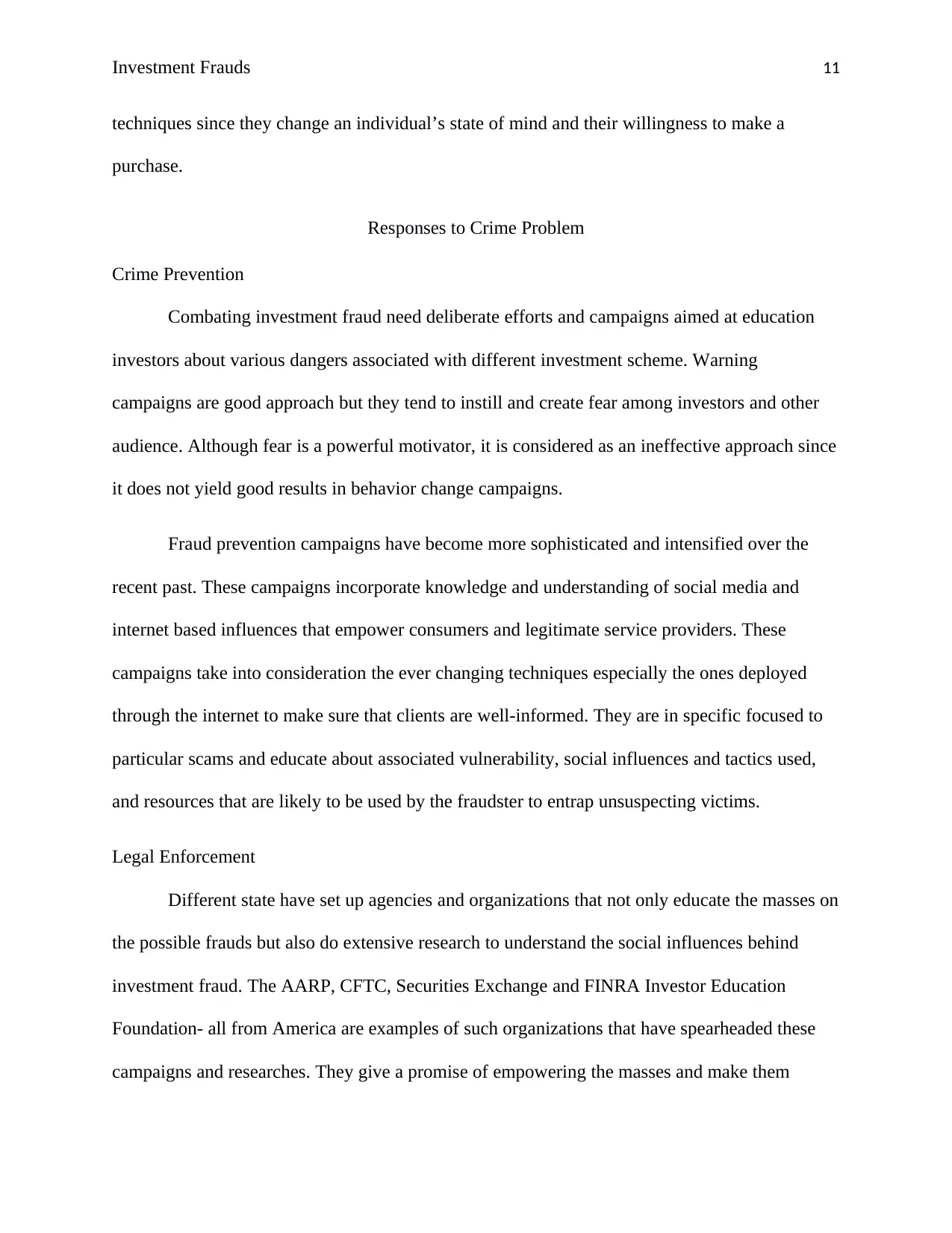
Investment Frauds 11
techniques since they change an individual’s state of mind and their willingness to make a
purchase.
Responses to Crime Problem
Crime Prevention
Combating investment fraud need deliberate efforts and campaigns aimed at education
investors about various dangers associated with different investment scheme. Warning
campaigns are good approach but they tend to instill and create fear among investors and other
audience. Although fear is a powerful motivator, it is considered as an ineffective approach since
it does not yield good results in behavior change campaigns.
Fraud prevention campaigns have become more sophisticated and intensified over the
recent past. These campaigns incorporate knowledge and understanding of social media and
internet based influences that empower consumers and legitimate service providers. These
campaigns take into consideration the ever changing techniques especially the ones deployed
through the internet to make sure that clients are well-informed. They are in specific focused to
particular scams and educate about associated vulnerability, social influences and tactics used,
and resources that are likely to be used by the fraudster to entrap unsuspecting victims.
Legal Enforcement
Different state have set up agencies and organizations that not only educate the masses on
the possible frauds but also do extensive research to understand the social influences behind
investment fraud. The AARP, CFTC, Securities Exchange and FINRA Investor Education
Foundation- all from America are examples of such organizations that have spearheaded these
campaigns and researches. They give a promise of empowering the masses and make them
techniques since they change an individual’s state of mind and their willingness to make a
purchase.
Responses to Crime Problem
Crime Prevention
Combating investment fraud need deliberate efforts and campaigns aimed at education
investors about various dangers associated with different investment scheme. Warning
campaigns are good approach but they tend to instill and create fear among investors and other
audience. Although fear is a powerful motivator, it is considered as an ineffective approach since
it does not yield good results in behavior change campaigns.
Fraud prevention campaigns have become more sophisticated and intensified over the
recent past. These campaigns incorporate knowledge and understanding of social media and
internet based influences that empower consumers and legitimate service providers. These
campaigns take into consideration the ever changing techniques especially the ones deployed
through the internet to make sure that clients are well-informed. They are in specific focused to
particular scams and educate about associated vulnerability, social influences and tactics used,
and resources that are likely to be used by the fraudster to entrap unsuspecting victims.
Legal Enforcement
Different state have set up agencies and organizations that not only educate the masses on
the possible frauds but also do extensive research to understand the social influences behind
investment fraud. The AARP, CFTC, Securities Exchange and FINRA Investor Education
Foundation- all from America are examples of such organizations that have spearheaded these
campaigns and researches. They give a promise of empowering the masses and make them
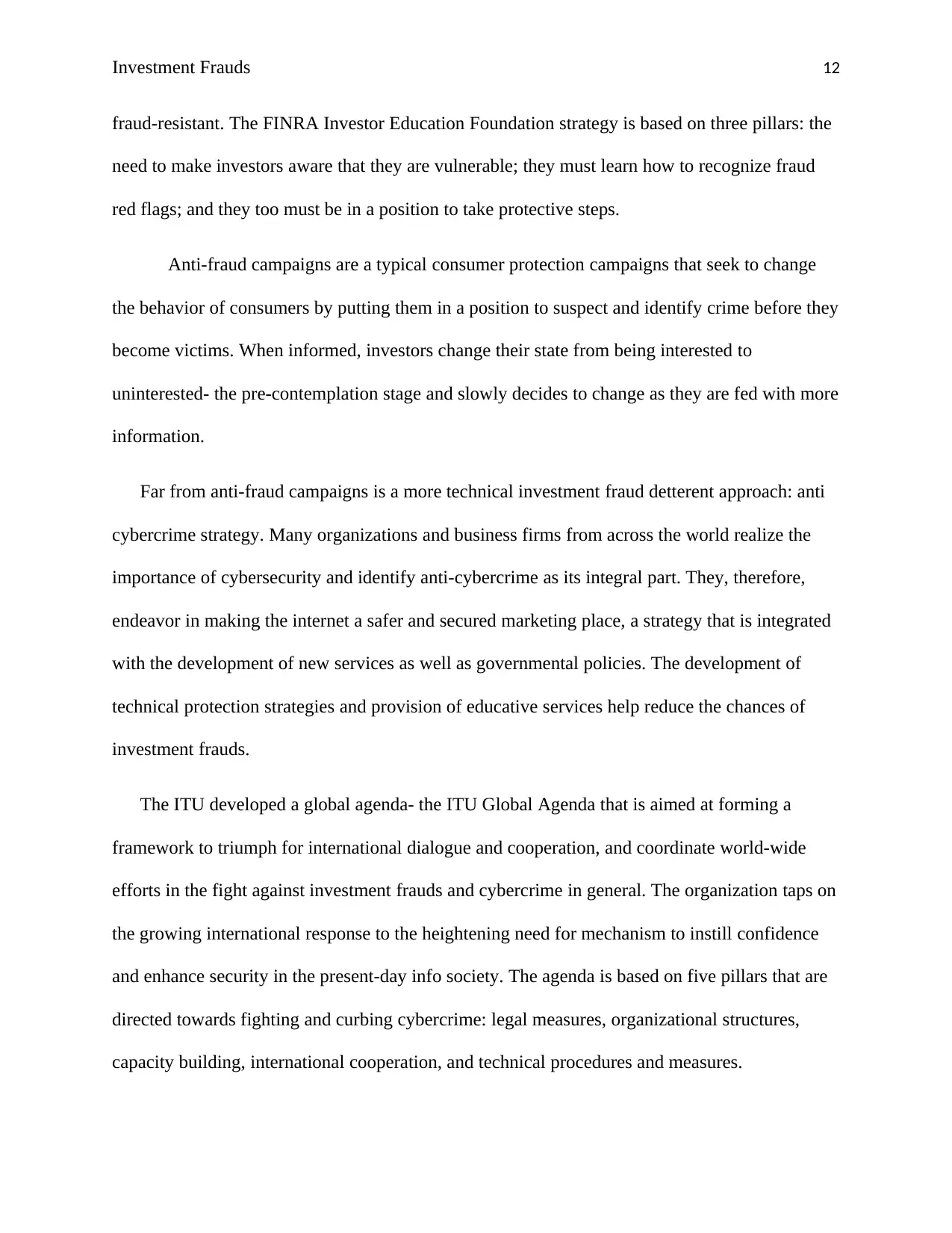
Investment Frauds 12
fraud-resistant. The FINRA Investor Education Foundation strategy is based on three pillars: the
need to make investors aware that they are vulnerable; they must learn how to recognize fraud
red flags; and they too must be in a position to take protective steps.
Anti-fraud campaigns are a typical consumer protection campaigns that seek to change
the behavior of consumers by putting them in a position to suspect and identify crime before they
become victims. When informed, investors change their state from being interested to
uninterested- the pre-contemplation stage and slowly decides to change as they are fed with more
information.
Far from anti-fraud campaigns is a more technical investment fraud detterent approach: anti
cybercrime strategy. Many organizations and business firms from across the world realize the
importance of cybersecurity and identify anti-cybercrime as its integral part. They, therefore,
endeavor in making the internet a safer and secured marketing place, a strategy that is integrated
with the development of new services as well as governmental policies. The development of
technical protection strategies and provision of educative services help reduce the chances of
investment frauds.
The ITU developed a global agenda- the ITU Global Agenda that is aimed at forming a
framework to triumph for international dialogue and cooperation, and coordinate world-wide
efforts in the fight against investment frauds and cybercrime in general. The organization taps on
the growing international response to the heightening need for mechanism to instill confidence
and enhance security in the present-day info society. The agenda is based on five pillars that are
directed towards fighting and curbing cybercrime: legal measures, organizational structures,
capacity building, international cooperation, and technical procedures and measures.
fraud-resistant. The FINRA Investor Education Foundation strategy is based on three pillars: the
need to make investors aware that they are vulnerable; they must learn how to recognize fraud
red flags; and they too must be in a position to take protective steps.
Anti-fraud campaigns are a typical consumer protection campaigns that seek to change
the behavior of consumers by putting them in a position to suspect and identify crime before they
become victims. When informed, investors change their state from being interested to
uninterested- the pre-contemplation stage and slowly decides to change as they are fed with more
information.
Far from anti-fraud campaigns is a more technical investment fraud detterent approach: anti
cybercrime strategy. Many organizations and business firms from across the world realize the
importance of cybersecurity and identify anti-cybercrime as its integral part. They, therefore,
endeavor in making the internet a safer and secured marketing place, a strategy that is integrated
with the development of new services as well as governmental policies. The development of
technical protection strategies and provision of educative services help reduce the chances of
investment frauds.
The ITU developed a global agenda- the ITU Global Agenda that is aimed at forming a
framework to triumph for international dialogue and cooperation, and coordinate world-wide
efforts in the fight against investment frauds and cybercrime in general. The organization taps on
the growing international response to the heightening need for mechanism to instill confidence
and enhance security in the present-day info society. The agenda is based on five pillars that are
directed towards fighting and curbing cybercrime: legal measures, organizational structures,
capacity building, international cooperation, and technical procedures and measures.
⊘ This is a preview!⊘
Do you want full access?
Subscribe today to unlock all pages.

Trusted by 1+ million students worldwide
1 out of 15
Related Documents
Your All-in-One AI-Powered Toolkit for Academic Success.
+13062052269
info@desklib.com
Available 24*7 on WhatsApp / Email
![[object Object]](/_next/static/media/star-bottom.7253800d.svg)
Unlock your academic potential
Copyright © 2020–2025 A2Z Services. All Rights Reserved. Developed and managed by ZUCOL.





